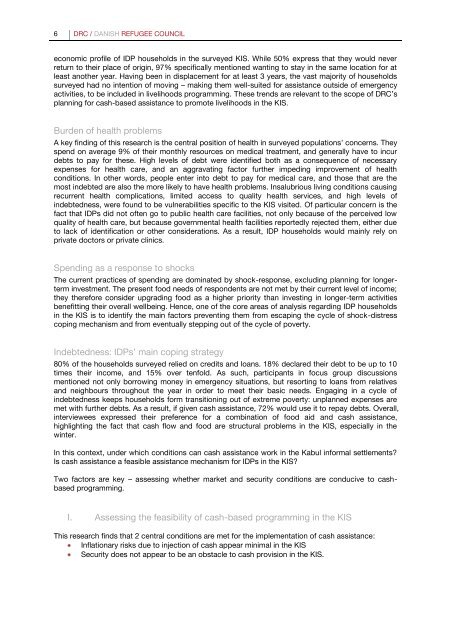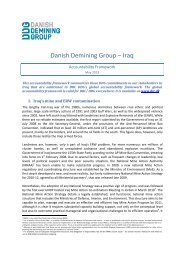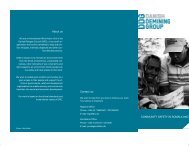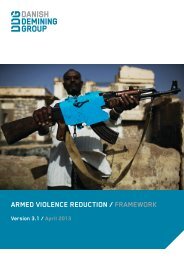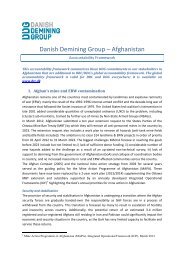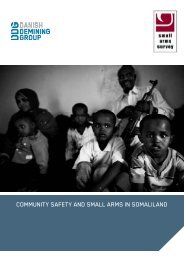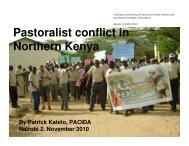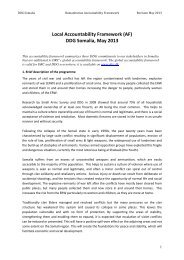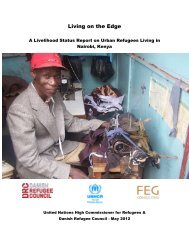Read the full report - Danish Refugee Council
Read the full report - Danish Refugee Council
Read the full report - Danish Refugee Council
Create successful ePaper yourself
Turn your PDF publications into a flip-book with our unique Google optimized e-Paper software.
6 DRC / DANISH REFUGEE COUNCILeconomic profile of IDP households in <strong>the</strong> surveyed KIS. While 50% express that <strong>the</strong>y would neverreturn to <strong>the</strong>ir place of origin, 97% specifically mentioned wanting to stay in <strong>the</strong> same location for atleast ano<strong>the</strong>r year. Having been in displacement for at least 3 years, <strong>the</strong> vast majority of householdssurveyed had no intention of moving – making <strong>the</strong>m well-suited for assistance outside of emergencyactivities, to be included in livelihoods programming. These trends are relevant to <strong>the</strong> scope of DRC’splanning for cash-based assistance to promote livelihoods in <strong>the</strong> KIS.Burden of health problemsA key finding of this research is <strong>the</strong> central position of health in surveyed populations’ concerns. Theyspend on average 9% of <strong>the</strong>ir monthly resources on medical treatment, and generally have to incurdebts to pay for <strong>the</strong>se. High levels of debt were identified both as a consequence of necessaryexpenses for health care, and an aggravating factor fur<strong>the</strong>r impeding improvement of healthconditions. In o<strong>the</strong>r words, people enter into debt to pay for medical care, and those that are <strong>the</strong>most indebted are also <strong>the</strong> more likely to have health problems. Insalubrious living conditions causingrecurrent health complications, limited access to quality health services, and high levels ofindebtedness, were found to be vulnerabilities specific to <strong>the</strong> KIS visited. Of particular concern is <strong>the</strong>fact that IDPs did not often go to public health care facilities, not only because of <strong>the</strong> perceived lowquality of health care, but because governmental health facilities <strong>report</strong>edly rejected <strong>the</strong>m, ei<strong>the</strong>r dueto lack of identification or o<strong>the</strong>r considerations. As a result, IDP households would mainly rely onprivate doctors or private clinics.Spending as a response to shocksThe current practices of spending are dominated by shock-response, excluding planning for longerterminvestment. The present food needs of respondents are not met by <strong>the</strong>ir current level of income;<strong>the</strong>y <strong>the</strong>refore consider upgrading food as a higher priority than investing in longer-term activitiesbenefitting <strong>the</strong>ir overall wellbeing. Hence, one of <strong>the</strong> core areas of analysis regarding IDP householdsin <strong>the</strong> KIS is to identify <strong>the</strong> main factors preventing <strong>the</strong>m from escaping <strong>the</strong> cycle of shock-distresscoping mechanism and from eventually stepping out of <strong>the</strong> cycle of poverty.Indebtedness: IDPs’ main coping strategy80% of <strong>the</strong> households surveyed relied on credits and loans. 18% declared <strong>the</strong>ir debt to be up to 10times <strong>the</strong>ir income, and 15% over tenfold. As such, participants in focus group discussionsmentioned not only borrowing money in emergency situations, but resorting to loans from relativesand neighbours throughout <strong>the</strong> year in order to meet <strong>the</strong>ir basic needs. Engaging in a cycle ofindebtedness keeps households form transitioning out of extreme poverty: unplanned expenses aremet with fur<strong>the</strong>r debts. As a result, if given cash assistance, 72% would use it to repay debts. Overall,interviewees expressed <strong>the</strong>ir preference for a combination of food aid and cash assistance,highlighting <strong>the</strong> fact that cash flow and food are structural problems in <strong>the</strong> KIS, especially in <strong>the</strong>winter.In this context, under which conditions can cash assistance work in <strong>the</strong> Kabul informal settlements?Is cash assistance a feasible assistance mechanism for IDPs in <strong>the</strong> KIS?Two factors are key – assessing whe<strong>the</strong>r market and security conditions are conducive to cashbasedprogramming.I. Assessing <strong>the</strong> feasibility of cash-based programming in <strong>the</strong> KISThis research finds that 2 central conditions are met for <strong>the</strong> implementation of cash assistance:Inflationary risks due to injection of cash appear minimal in <strong>the</strong> KISSecurity does not appear to be an obstacle to cash provision in <strong>the</strong> KIS.


